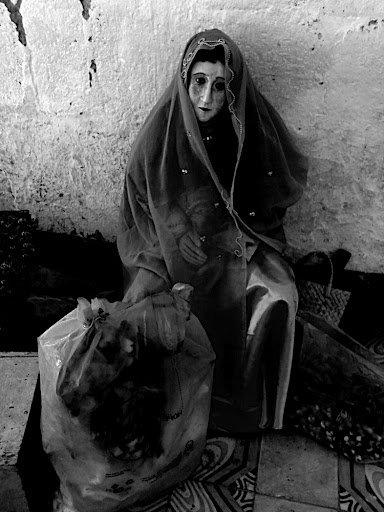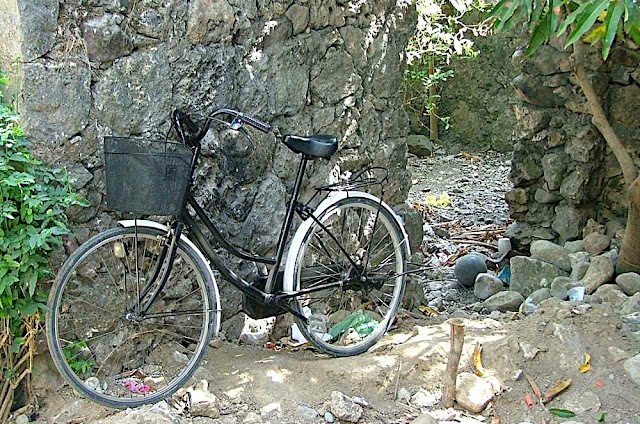It's not our summer dress, although it looks like one (the masthead background the color of the de rigueur khaki shorts and bush hat so beloved of British colonists in Africa and India, where they felt particularly warm in the alangáang), it's just something that the ezine will more or less permanently look like. We also put in that blue-green bar, the color of dark green slate, after searching for the least-used combination. Then we have the magazine "leaves" peeping out of the left margin of the masthead (we can never wean ourselves out of the print medium, where we, our generation of writers, all nursed). Nice touches and distinctions, I like to think. More or less permanent because the colors might yet change with the seasons, but the graphic elements will remain. We will stay with them for good, only in our colors will the online magazine be a work in progress. We have a new logo as well, integrated with the masthead. It is self-explanatory, composed of the two simple things that represent us, the pen (unless you prefer a mouse, the electronic species), and the double curlicue. Poems and pictures or images. We have a note on our new logo in the About Us page.
Perhaps this is what we have to atone for in this extended season of mortification: the visual changeability of our magazine. No longer. We have come into our own stride, even after fixing every now and then our visuals. Our readership is growing, from the Philippines and abroad, we shoot up the lists of blog tracking sites whenever we put out a new issue. We are being read, and apparently appreciated (my friends tell me so!). When the time comes for it, we will publish your Readers' Comments among these pages. In the meantime, we go on with our theme, and here are...
More Poems of Summer

Kristian Cordero
Stabat Mater
Basi sa retratong kua ni Adrian Remodo
Ini an babaying
hahalian nin talukbong na itum
na garo baga papahanguson giraray
nin huli sa pagkabuhay kan saiyang aki.
Ini an babaying sa bilog na taon
aadornohan ta, kokoronahan,
tatawan nin dakul na pangaran
sigun sa satuyang pangangaipuhan:
Lourdes, bulunga an lugad ko na kawsa kan sinturon
orog na idtong dai ko kaya pang sabihon.
Fatima, kuaha an sakuyang kapung’awan
sa sakuyang hawak na pinabayaan,
Rosario, ampona an gabos kong aki na naghali,
sinda na dai pa ngani aram kun pano an pagpuli.
Peñafrancia, dangoga an sakuyang agrangay
nin huli sa kapagtiosan, garo nadukotan nin salabay,
Remedios, parigona an pagtubod ko sa paglaom
na sa pagsakit maabot man giraray an sinarom.
Ngonyan, uya an babaying ini sa gilid
naghahalat kan saiyang giraray na pagsakat sa karo,
aadornohan ta man giraray nin mga burak
tatakudan kan platang pusong may pitong garod,
na ginusgos, pinakintab nin gaas asin algudon.
Tatalukban nin itum na panyo na hahalion
kan mga aking pinili tang magin anghel
na yaon ngonyan sa luwas nagraralamagan,
na kun madutaan kan saro, nagigin siring man
sa imahen, napundo, dai nahiro siring sa istatwa
ta bawal an maghangos, ta nagigin taya.
March 29, 2008
Stabat Mater
Based on the photograph by Adrian Remodo
She is the woman
whose black veil we will lift
as if to let her breathe again
because her son has come back to life.
She is the woman whom, during the whole year,
we dress up and adorn, we crown,
we give many names,
depending on what we need from her:
Lourdes, heal my gridle-wound,
especially the one I cannot utter,
Fatima, take away this painful longing
for the body I have abandoned,
Rosario, take under your wing my children who’ve left,
they don’t know their way back,
Peñafrancia, hear my anguish,
suffering has stuck to me like jellyfish,
Remedios, strengthen my hope
that pain has its own sunset.
This woman now sits in a corner,
waiting to be put on the carriage,
where we will bedeck her with flowers,
pin on her breast the heart pierced by seven spears,
that we have rubbed shiny with cotton dipped in kerosene.
Then we will veil her in black, which the children
we have chosen to be angels will lift,
who are now playing tag in the yard, any of whom
when tagged will stop, stand still like a statue,
like the woman’s image: it is forbidden
of her to even breathe, or she’s it.
(tr. MLK)

Marne L. Kilates
Tinker
He inhabited the last of our
Tin-pan afternoons. Creaking on his
Ancient bicycle, he invaded
Our household siesta, unholiest of hours,
When Grandmother had just retired
From her post-prandial chores.
The wind and the jarring on the dirt path
Clanged his fenders, the frame
Groaned and whined under his saddle.
The clank and clatter of his tools
And accoutrements preceded him.
At the door he set up his trade.
He stood his bicycle on its stand,
Engaged the chain onto the gears
Of the grindstone. From the depths
Of an old army duffel he took
Hammers, awls, pliers, and said:
Bring out your worn aluminium vessels,
Casseroles cracked, dented or holed,
Broken umbrellas, chipped knives,
Dull scissors. Let me refine and repair all
Manner of cutlery crude and flawed.
And the afternoon ground and unwound
And wove in the spokes of his bicycle.
Throwing off sparks, it spun, hummed
And trembled in the small orbits
Of sprocket, chain and grindstone.
And as he sealed all cracks, plugged
All holes, sewed with gut, twine or wire,
The world came together once more:
In the prolonging of use, in the postponing
Of age, in the mending of time’s damage.
At dusk, Grandmother sent him off with our
Small emoluments. And then there was only
The clank and clatter of his ancient bicycle
As it rounded the bend. (This I remember
As my wife stirs soup in her new casserole.
It is teflon-coated, practically disposable.)
January 13, 1996
(from Poems en Route, University of Santo Tomas Publishing House, 1998)
PHOTOS: The Virgin in a corner, by Adrian Remodo; a bike among stone walls in Batanes, by Marne Kilates)